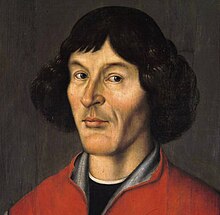This week’s topic about space and art is the most unique topic that we have covered throughout the quarter so far, because it not only combines all of the previous topics into one discipline, but also because of the vast uncertainty of space that allows for the unlimited imagination of what space actually is. Humans have been interested by the stars for thousands of years, as the ancients built massive monuments, such as Stonehenge, to track the movement of the Sun and stars. Our understanding of space increased during the Renaissance Era, as scientists such as Copernicus made discoveries that shined some light on how the universe works, but the actual exploration of space was still very primitive and various major components of the universe remained unknown.
 |
| Portrait of Copernicus |
It was not until the Soviet Union launched Sputnik 1 on October 4th, 1957, that our understanding of space exploration was elevated to an unprecedented level. This event sparked a major space race between the two Cold War rivals, the United States and the Soviet Union, as they each competed to make breakthroughs and discoveries in the field of space exploration. For example, the Soviet Union became the first country to send a biological organism into space when they launched a dog named Laika into Earth’s orbit in November of 1957. This was immediately followed by the launch of Ham, a chimpanzee, into space by the United States. This heightened level of competition between the two rivals would ultimately pave the way for the first man on the moon, as Neil Armstrong and Buzz Aldrin became the first men to land on the moon during the Apollo 11 space mission.
 |
| Laika, the first dog in space |
The space race not only helped to create scientific breakthroughs in the field of space exploration, but it also sparked an interest in space that had never previously been present in society. It was very interesting to see how different artists portrayed their interest in space through movies and television shows such as Star Trek, The Jetsons, and Star Wars. This interest in space has only increased through the years, as artists today have attempted to create more advanced portrayals of the universe through films such as Interstellar, Gravity, and The Martian.
 |
| A scene from the movie Interstellar |
Jarus, Owen. “Stonehenge: Facts & Theories About Mysterious Monument.” LiveScience, Purch, 18 Aug. 2017, www.livescience.com/22427-stonehenge-facts.html.
Vesna, Victoria. “8 Space pt1”. Youtube, 29 July 2013, Web. https://www.youtube.com/watch?v=6ZIqTR332l8.
Vesna, Victoria. “8 Space pt2”. Youtube, 29 July 2013, Web. https://www.youtube.com/watch?v=hLZMDpoP-u0.
Vesna, Victoria. “8 Space pt3”. Youtube, 29 July 2013, Web. https://www.youtube.com/watch?time_continue=481&v=4WOqt_C55Mk.
Vesna, Victoria. “8 Space pt4”. Youtube, 29 July 2013, Web. https://www.youtube.com/watch?v=J5ClKO6AJPo.
Vesna, Victoria. “8 Space pt5”. Youtube, 29 July 2013, Web. https://www.youtube.com/watch?v=WnSUHMXBmdg.
Vesna, Victoria. “8 Space pt6”. Youtube, 29 July 2013, Web. https://www.youtube.com/watch?v=VYmOtFjIj0M.


No comments:
Post a Comment